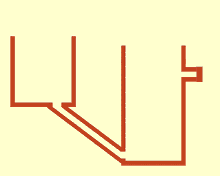communicating vessels on:
[Wikipedia]
[Google]
[Amazon]

 Communicating vessels or communicating vases
Communicating vessels or communicating vases
 In cities, water towers are frequently used so that city plumbing will function as communicating vessels, distributing water to higher floors of buildings with sufficient pressure.
In cities, water towers are frequently used so that city plumbing will function as communicating vessels, distributing water to higher floors of buildings with sufficient pressure.
 Communicating vessels or communicating vases
Communicating vessels or communicating vasesMario Bunge
Mario Augusto Bunge ( ; ; September 21, 1919 – February 24, 2020) was an Argentine-Canadian philosopher and physicist. His philosophical writings combined scientific realism, systemism, materialism, emergentism, and other principles.
He was a ...
, ''Philosophy of Science: From Explanation to Justification'', 1998, , p. 369 are a set of containers containing a homogeneous fluid
In physics, a fluid is a liquid, gas, or other material that may continuously motion, move and Deformation (physics), deform (''flow'') under an applied shear stress, or external force. They have zero shear modulus, or, in simpler terms, are M ...
and connected sufficiently far below the top of the liquid: when the liquid settles, it balances out to the same level in all of the containers regardless of the shape and volume of the containers. If additional liquid is added to one vessel, the liquid will again find a new equal level in all the connected vessels. This was discovered by Simon Stevin
Simon Stevin (; 1548–1620), sometimes called Stevinus, was a County_of_Flanders, Flemish mathematician, scientist and music theorist. He made various contributions in many areas of science and engineering, both theoretical and practical. He a ...
as a consequence of Stevin's Law. It occurs because gravity
In physics, gravity (), also known as gravitation or a gravitational interaction, is a fundamental interaction, a mutual attraction between all massive particles. On Earth, gravity takes a slightly different meaning: the observed force b ...
and pressure
Pressure (symbol: ''p'' or ''P'') is the force applied perpendicular to the surface of an object per unit area over which that force is distributed. Gauge pressure (also spelled ''gage'' pressure)The preferred spelling varies by country and eve ...
are constant in each vessel (hydrostatic pressure
Hydrostatics is the branch of fluid mechanics that studies fluids at hydrostatic equilibrium and "the pressure in a fluid or exerted by a fluid on an immersed body". The word "hydrostatics" is sometimes used to refer specifically to water and o ...
).
Blaise Pascal
Blaise Pascal (19June 162319August 1662) was a French mathematician, physicist, inventor, philosopher, and Catholic Church, Catholic writer.
Pascal was a child prodigy who was educated by his father, a tax collector in Rouen. His earliest ...
proved in the seventeenth century that the pressure exerted on a molecule of a liquid is transmitted in full and with the same intensity in all directions.
Applications
Since the days of ancientRome
Rome (Italian language, Italian and , ) is the capital city and most populated (municipality) of Italy. It is also the administrative centre of the Lazio Regions of Italy, region and of the Metropolitan City of Rome. A special named with 2, ...
, the concept of communicating vessels has been used for indoor plumbing, via aquifer
An aquifer is an underground layer of water-bearing material, consisting of permeability (Earth sciences), permeable or fractured rock, or of unconsolidated materials (gravel, sand, or silt). Aquifers vary greatly in their characteristics. The s ...
s and lead pipes. Water will reach the same level in all parts of the system, which acts as communicating vessels, regardless of what the lowest point is of the pipes – although in practical terms the lowest point of the system depends on the ability of the plumbing to withstand the pressure of the liquid.
 In cities, water towers are frequently used so that city plumbing will function as communicating vessels, distributing water to higher floors of buildings with sufficient pressure.
In cities, water towers are frequently used so that city plumbing will function as communicating vessels, distributing water to higher floors of buildings with sufficient pressure.
Hydraulic press
A hydraulic press is a machine press using a hydraulic cylinder to generate a compressive force. It uses the hydraulic equivalent of a mechanical lever, and was also known as a Bramah press after the inventor, Joseph Bramah, of England. He inven ...
es, using systems of communicating vessels, are widely used in various applications of industrial processes.
See also
*Artesian well
An artesian well is a well that brings groundwater to the surface without pumping because it is under pressure within a body of rock or sediment known as an aquifer. When trapped water in an aquifer is surrounded by layers of Permeability (ea ...
* Water level (device)
A water level ( '' lfadolasticho') is a siphon utilizing two or more parts of the liquid water surface to establish a local horizontal and vertical, horizontal datum reference, line or plane of reference. It is used to determine the apparent g ...
References
{{reflist Hydrostatics Pressure Aquifers Water supply Hydrology